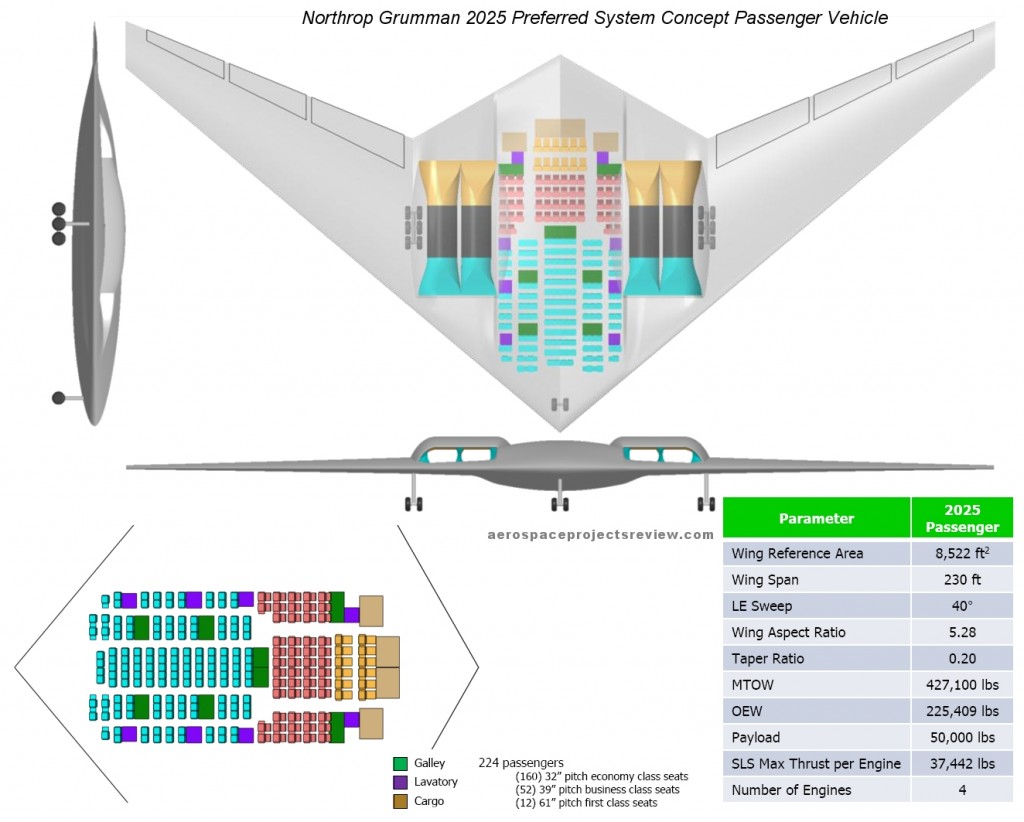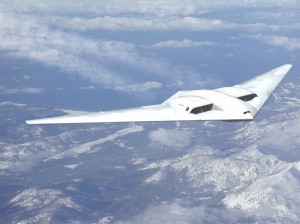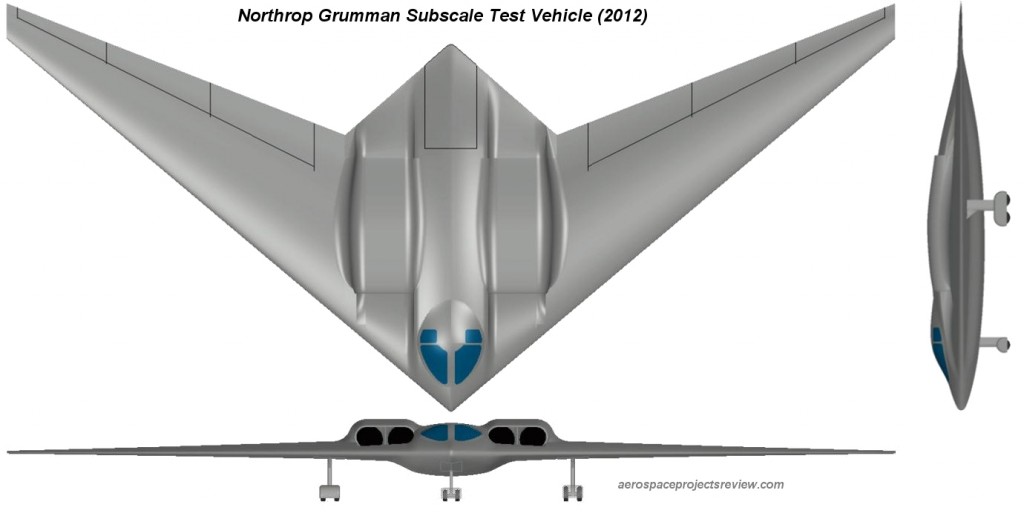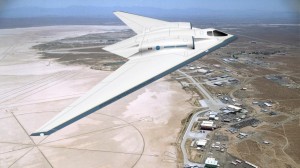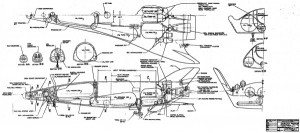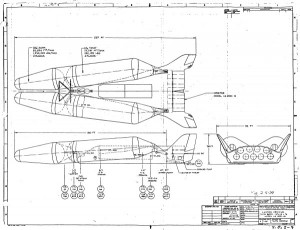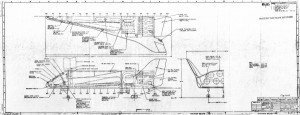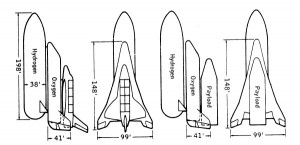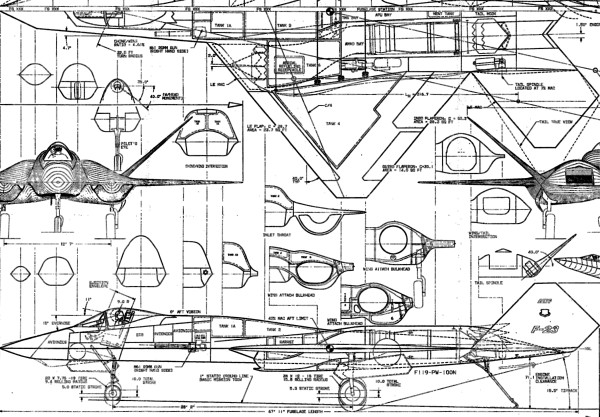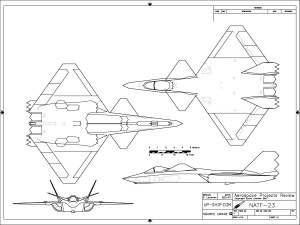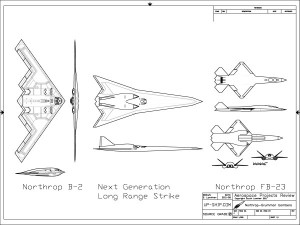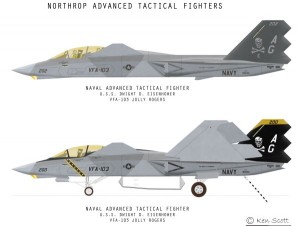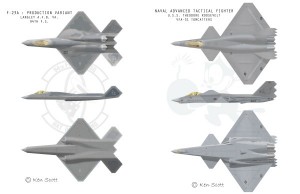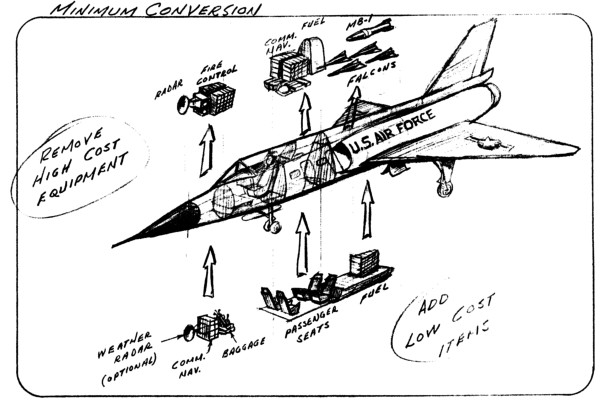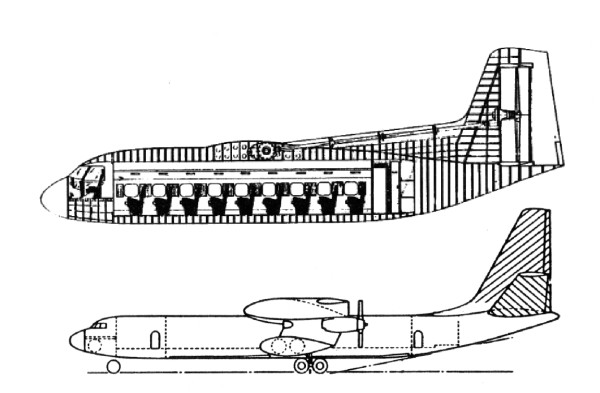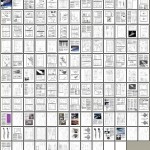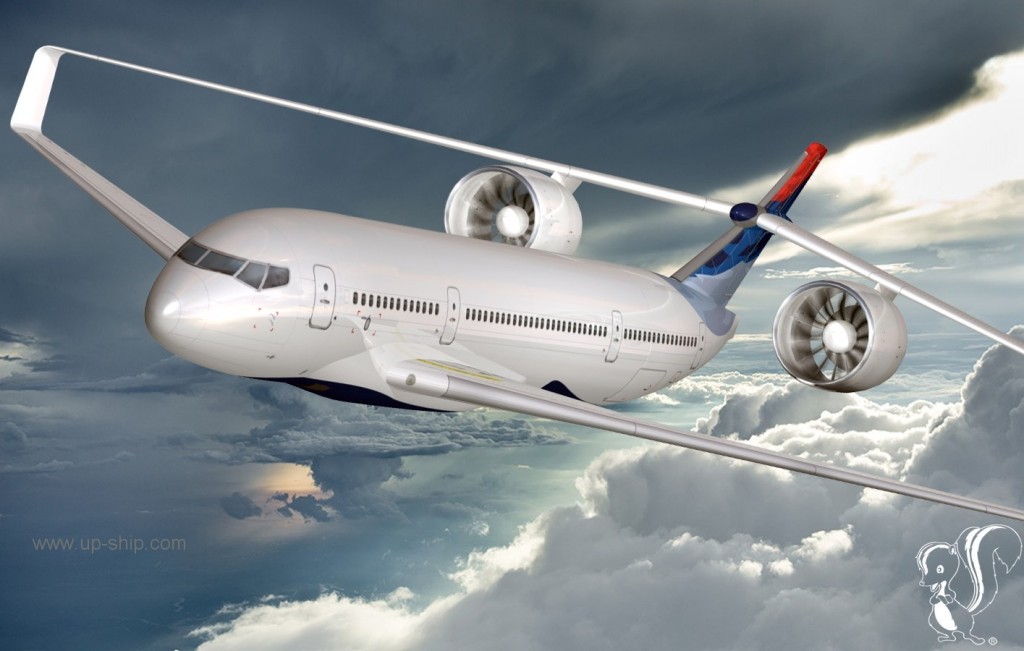Here are images of the NG concept of the flying wing jetliner designed for the NASA “Environmentally Responsible Aviation” program. Cruise for this design is about Mach 0.82 at 36,000 feet, for a nominal range of 8,000 n.m. Fuel burn was assumed to be 41.5% reduce from a 1998 baseline.
NG has recently unveiled their concepts for next generation jetliners under the NASA “Environmentally Responsible Aviation” program. NG is not known for airliners, but rather military vehicles… most famously the B-2 stealth bomber. Not surprisingly, their jetliner concept looks a whole lot like a stealthy flying wing bomber. It seems a reasonable suspicion that their work under NASA contract either makes use of existing military design work… or will form the basis of future military design work.
Since the Northrop Grumman ERA N+2 design is revolutionary (at least in terms of airliner design), they have produced a design of a Subscale Test Vehicle. At 143-foot span, it’s about 60% the size of the passenger version and 55% the size of the cargo carrying final version.
The STV would seem to be sized right for a bomber, while the passenger and cargo carrying version would be rather large… more sized for arsenal aircraft, loaded with a vast number of cruise missiles and the like.
Downloading FAQ
I keep getting asked the same questions, so I guess I should have a Frequently Asked Questions page for my downloads. Well, here it is.
Q01: How does this work?
A: It’s not an automated system. The way it works is that when you place an order through Paypal, Paypal sends me an email notifying me of the order. I then reply to the email address listed in the order, providing you with the web address where you can find your document, plus the username and password you’ll need in order to access it.
————–
Q02: “I just ordered a document. It’s been a whole 2 seconds, and I don’t have it yet. Where is it?”
A: I’m asleep/out buying groceries/fighting off hordes of zombies. I’ll respond to your email just as soon as I can.
————–
Q03: “I just ordered a document. It’s been a whole 24 hours, and I don’t have it yet. Where is it?”
A1: Check your “spam bucket.” Some spam filters see response messages such as you’ll get from me as spam, since there is a web address listed in it.
A2: Are you using the email address attached to the Paypal account? The response email with all your download info will be sent to the Paypal-listed email address. If you are using someone else’s Paypal address, or something like that, then *they* will receive the reply.
A3: On rare occasion, the automated Paypal system that sends me order notifications fails to do so. Thus I don’t know you’ve ordered something. Feel free to send a “where’s my stuff” email to: ![]()
A4: Search your inbox. You might have gotten the message, but not noticed or recognized it. The header will be something like “Re: Notification of payment received” or “Re: Payment received from YourEmail@YourEmailDomain.com.”
————–
Q04: “I ordered a document for downloading, but the username and password aren’t working.”
A: By far the most common reason for this is either you’re typing the password wrong… or if you are using cut-and-paste, you are grabbing a spurious blank space. Try again, making sure to cut *just* the password.
————–
Q05: “I tried that, but it’s still not letting me in.”
A: The second biggest offender is your web browser. Something or other to do with cookies, or something. If you have another web browser (Netscape, Explorer, Firefox, whatever), try that.
————–
Q06: “I’ve downloaded a PDF file. What do I need to open it?”
A: Adobe Reader. It’s a free program.
————–
Q07: “I’ve downloaded a ZIP file. What do I need to open it?”
A: Any modern computer should have come with an unzipping program built in. If not, do a search for “unzip,” and download a program to your liking.
————–
Q08: “I ordered a drawing set, and can see the files named ‘XYZ halfsize.gif’ and ‘XYZ quartersize.gif,” but not the full size image. Why?”
A: Some of the full size images are quite large. Sometimes they are so large that operating systems and/or image viewing and processing programs simply refuse to show them. All of the full-size images I sell are viewable on *my* system, which is a bit antiquated… but that doesn’t mean that they will be viewable on *all* systems. This is why I include the “halfsize” and “quartersize” versions, so that everybody should be able to see the images. You do still have the full-rez image… try looking at it on another computer.
————–
Q09: “Ooops, I ordered the wrong thing. I wanted A, but I seem to have actually ordered B. Can I have A?”
A1: If the error is due to something screwy in the webpage – rare, but it has happened that a typo in the HTML coding can lead to this sort of thing – then I’ll fix you right up with a proper download of A. Keep the other item, free of charge.
A2: A slightly more common error is on my part… you order SDOC4, say, and I mistakenly send you the link to SDWG4. In that case, let me know, and I’ll fix you right up with what you actually ordered. Keep the other item, free of charge.
A3: If the error is due to you simply ordering the wrong thing… well… the problem with digital files is that you can easily make copies of them, and thus cannot really be returned. So if my policy was to automatically “correct” “mistakes,” then it’d be the easiest thing in the world to scam me right out of half my catalog.
So… no. If you wanted A but mistakenly ordered B, I’ll be happy to fill your *next* order for A.
————–
Q10: “I bought one of your documents, and want to extract the images from it for my own devious purposes. However, it’s password protected. Gimme the password. Gimme.”
A: The documents (air docs, space docs and APr’s, but not DCD’s) are password protected *solely* to try to minimise piracy of ’em. The documents will open just fine and will print just fine at high rez, but image and text extraction will present a challenge. I’ve had issues with people taking the data I’ve worked hard to find and prepare and then turning it around and reselling it (grrr). However, if you have a valid use for extracted images, let me know, and I’ll almost certainly fork over the relevant password.
————–
Q11: “I want you to add me to your mailing list.”
A: No can do. The system I use now requires that the person who wants on the mailing list add themselves (I can add you, or the system will think I’m a spammer). So, simply go HERE and add your email address.
I’ll update this FAQ as questions come in. Feel free to comment
At long last, Aerospace Projects Review issue V3N2 is now available.
The main article, about 90 pages worth, covers the Lockheed STAR Clipper concept.This was a one-and-a-half stage space shuttle concept. Starting in 1968 for the USAF, the concept lasted well into Phase B of the Space Shuttle program for NASA, and in altered form into the 1990’s. This article has a very large number of detailed schematics of many different forms, including the original small 1.5 Stage To Orbit design, numerous variations on that concept, fully reusable two stage versions with manned boosters, giant concepts for Solar Power Satellite logistics and miniature versions for the USAF in the 1980s.
Also included is an article covering antecedents and derivatives of the Northrop F-23 stealth fighter. Included are early designs such as the “Christmas fighter” and several “platypus” concepts, the F-23A operational fighter design, the NATF-23 concept for the US Navy with aft mounted wings and canards, the single-engined Multi Role Fighter (from the competition that led to the F-35) and perhaps most interestingly, the F/B-23 regional bomber, of eBay infamy. This article is illustrated with a mix of photos of official Northrop display models, official Northrop diagrams, all-new scale diagrams and color artwork especially commissioned for this article.
Dennis R. Jenkins provides an article on a Convair concept for converting the F-106 interceptor into a small supersonic transport. Compare this to Convair idea of converting the B-58 Hustler into an SST!
And finally, two aerospace history “nuggets,” the Vanguard Model 18 VTOL transport and a Northrop laminar flow control multipurpose long-duration aircraft.
You can see the entire issue here:
It is available in three formats. Firstly, it can be downloaded directly from me for the low, low price of $10. Second, it can be purchased as a professionally printed volume through Magcloud; third, it can be procured in both formats. To get the download, simply pay for it here through paypal.
——–
———
To get the printed version (or print + PDF version), visit my MagCloud page:
ALSO AVAILABLE: V3N2 Addendum, with 65 pages formatted for 11X17 sheets. Includes larger format (and higher rez images) along with additional artwork and diagrams that were not in issue V3N2 due to space constraints.
V3N2 Addendum download order: $5.00
———
In recent decades, the first “A” in NASA – “Aeronautics” – has received the short end of the attention and funding stick. At the same time, aeronautics has not exactly leaped forward. Feel free to draw a link, or conclude that “correlation does not equal causation.” Whichever makes you happy.
Still, NASA has been pushing industry a little bit in the last few years for advanced jetliner ideas. Mostly the goal is for low fuel-cost airliners; in order to be more PC, these are being sold more for their supposed environmental friendliness than their lower cost of operation. In any event, the designs have included not only alternate fuel designs (such as hydrogen) but even all-electric jetliners… whopping great battery packs which would be swapped out between flights rather than conventional refueling operations.
Lockheed has been working on this as well as Boeing. While Lockheed hasn’t built an airliner since the L-1011, they’ve retained some interest in SST’s, occasionally cranking out a design for a large passenger jet or a small corporate jet. But the economic collapse and the increased price of oil have pretty much put the kibosh on those plans. But they’ve also produced artwork for subsonic designs. While diagrams and good technical data have so far evaded me, some art is available showing a high efficiency subsonic concept. The future is entirely conventional in appearance, but box wings of high aspect ration have replace the conventional wing and tail. Suspended from the aft wing are turbofan engines of extremely high bypass ratio. The result should be a design with impressive fuel economy.
Note that the wings on this jetliner have unusually high aspect ratios (i.e. they’re “skinny”). High AR wings are more efficient. But high AR wings are also structurally weak, prone to simply snapping off. The “box wing” arrangement allows the aircraft to have two high AR wings joined at the tip, making them much, much more structurally sound. Plus, the vertical surface at the tip serves as a tip-fin, increasing efficiency further.
Example: take a wood or aluminum yard stick. A very “floppy” structure. Now take two and tape the ends together, like the box wing. Hold the other ends apart and fix then to another piece of wood or some such (replicating the fuselage). If you mount one yardstick low and the other high – like the box wing – you’ll find that this is a surprisingly rigid structure.
This post originally appeared HERE.
